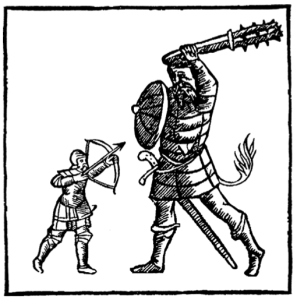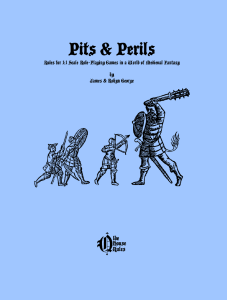The ranks of zero edition style games are increasing. Pits & Perils is a game in this mode, presented as a single PDF booklet of around 80 pages. It seems letter-sized when I open the file on a computer, but uses a generous typewriter font that is easily readable on my tablet without zooming, and I suspect it would print well as a digest-sized hardcopy. Illustrations are sparse and done in a charming woodcut style (digital excerpts mostly drawn from History of the Nordic Peoples by Olaus Magnus). The tone is reminiscent of pre-advanced Gygax, concise but enthusiastic, which I assume is intentional based on the other design choices.
Tasks are resolved by rolling 2d6. Nine or higher is a success in combat, while seven or higher is a success out of combat. As you might expect, some character and situational bonuses apply, but not enough to dilute the essential elegance and simplicity of the system, unlike many games that rely on modifiers. In combat, damage inflicted is one point for rolls of 9 to 11 and two points for 12 or higher. Most rules needed for common dungeon exploration tasks are handled elegantly. Encumbrance is just flatly limited to 10 items beyond armor. “Anything more is simply too much. Characters cannot perform if overburdened with equipment, and gold coins are bulky in large amounts” (page 17). Suffocation and drowning is handled simply with saving dice and the accumulation of damage.
Rather than roll 3d6 down the line during character creation, as is traditional, the player instead rolls once for exceptional abilities (which happen to be drawn from the classic six). This rule is inspired. Most of the time, this will result in only a single “ability,” but players can choose two on rolls of eleven or higher. The actual distribution is a bit strange (for example, you roll 2d6 and only get “strength” if you roll 2 or 11 or higher and choose it). Further, there are some minor complications (such as that dwarves treat rolls of strength or charisma as constitution instead). For a simple, pickup game of D&D I would be tempted to use a mutation of this rule, perhaps simplifying it to roll 1d6 for exceptional stat and then grant a simple +1 bonus to whatever is related to that stat.
There are six classes: cleric, dwarf, elf, fighter, magician, thief. Each one of these seems to roughly associate with one of the abilities, though I am not sure if this structure was intentional. The experience progression tables require less XP than many similar games, with second level being achieved around 200 XP for most classes and mid levels occurring around the low thousands. For example, a fighter with 3200 XP is 6th level according to these charts. That is probably not a bad approach. Who has time for multi-year campaigns, anyways? Class abilities are minimal. Fighters get +1 to attack dice, the use of all weapons and armor, and two attacks at 9th level. That’s it. There are no other bonuses hidden in other advancement schedules such as can be found in the OD&D attack matrices or saving throw tables. The magic system uses a very simple spell point system with no levels. Casting any spell costs one point.
There are a few things that I am uncertain about, including:
- The benefit of wearing armor is just bonus hit points
- All projectile missile weapons seem to get +1 damage for being two-handed
- Thieves need to wait until 9th level (“robber baron”) for a backstab ability
- Random encounter math implies only 1 encounter every 36 turns
These are relatively minor concerns within the overall scope of the game and are easily adjusted by a referee, but are still worth noting. Of greater impact for gameplay is the relationship between character HP and damage. As noted above, most attacks deal only 1 or 2 damage and there are very few potential bonuses to damage. Using a two-handed weapon grants +1 (making every hit do either 2 or 3 damage), and there are a few magic weapons that can increase damage. Relative to damage potential, character HP (which is static, based on class and level) seems high, ranging at first level from 5 (for magicians) to 10 (for fighters). This is not necessarily a bad approach, but it is most definitely an impactful choice, leading to far more durable PCs than in, for example, OD&D or B/X.
I often have a short attention span when it comes to reading game content such as spells, feats, magic items, monster descriptions, and so forth, usually just skimming such material while reading the occasional entry in full. In this case though, I read every single entry in the entire book. Here are a few choice quotes, to give you a sense of the rules.
BOLT scores 1d6 hits on a single target. The caster adds +1 per 3 levels gained, so a 3rd level magician would deliver 1d6+1 hits. Lightning can sunder doors up to 5′ thick and melt gold within 10′ of the point of impact.
–Page 14
Harpies attack with their two razor sharp claws. About one-third (1-2 in 1d6) are SIRENS. These use an evil song to hypnotize victims within 30′. These must save or fall into a mindless trance and present themselves for slaughter.
–Page 36
A MAGICIAN’S HAT looks like an ordinary pointed cap. However, the wearer can pull any normal/non-magical item, like a ladder or rope, out of the hat up to 3 times per day. The item must be of less than 10 GP value, so armor, weapons, and other valuables cannot be produced. This includes foodstuffs and living things of all kinds, even rabbits!
–Page 51
Exploration and problem solving is the meat and drink of these games, provided the referee makes it challenging and fun.
–Page 65
Final thoughts? Recommended if you enjoy reading variations on the 0E theme. The PDF can be bought at RPGNow for $5 and happily does not include a watermark.


